.
Imagine having fresh vegetables from your garden throughout the entire growing season. With succession planting, you can transform your garden from a place with a one-time harvest to a continuous source of fresh produce!
When I started as a new gardener, I was overrun with harvest for a few weeks every season for the first couple of years. We couldn’t possibly eat or preserve everything that was ripe then and the neighbours started changing the roadside when they saw us coming from fear of being forced upon cucumbers or zucchini. Some weeks later, however, the situation was quite the opposite and we had to run to the supermarket to buy all those vegetables we had in abundance a short while before.
It took me a while to figure out how to ensure a continuous harvest throughout the whole season without any “gaps”. With a bit of smart planning, the next year’s harvest was a good deal more satisfying and we had almost no gaps between harvests. Over the years, I improved my planting plan and now I can proudly say that I can continually harvest from spring to late autumn.
The trick is to sow or plant vegetables whenever there is a gap where some other vegetables have been harvested.
I’ve been using these techniques for years, and I’m excited to share how you can maximize your garden’s potential.
Understanding Succession Planting
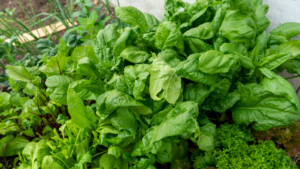
By cleverly sowing or planting whenever there are gaps in the beds after harvesting, we can ensure a continuous harvest throughout the whole season. This successive planting is called (drumroll, please!): “succession planting”. Apart from a continuous harvest, there are a lot more benefits and advantages of succession planting
Succession planting reduces weeds by constantly keeping the soil covered. Whenever we have harvested one kind of vegetable, we sow or plant right afterwards so that the gaps close fast and weeds don’t stand a chance. It also keeps the soil moist.
With clever planning and observing what plants go well together (i.e. mixed culture), staggered planting guarantees our soil’s health. For example: when we plant legumes like peas or beans which collect nitrogen before or after hungry plants like cabbages or tomatoes, we can ensure that the soil won’t be leached out.
Succession planting also helps control pests and diseases. By avoiding growing large numbers of the same vegetables at once, we create a natural barrier. Besides, different growth stages attract different beneficial insects.
When, due to the weather, pests or disease one crop fails, succession planting is our backup plan and reduces the risk of losing our entire harvest.
By spreading out planting and harvesting times, we prevent an overwhelming workload, either of planting or harvesting. As I told you before, I had this experience when I started gardening. I had lots to do in spring what with sowing and planting and then later with harvesting simply everything at once!
The different methods of succession planting
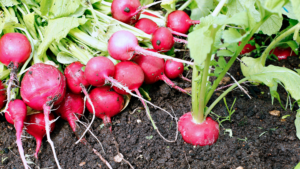
Succession planting is not only a season-long lettuce harvest. Instead, there are quite a few different methods to do it:
Same-crop succession
This covers the above-mentioned lettuce harvest. By planting the same crop every few weeks, for example lettuce, we ensure a constant harvest of this crop throughout the season. Make sure to always choose a different place for the same crop. Otherwise, the soil will get leached out of nutrients.
Different-crop succession
This means following one crop with a different crop, for example plant tomatoes after early peas.
Interplanting
A clever way to make the best use of your space is to plant fast-growing vegetables between slow-growing ones. A good example for interplanting is to cultivate radishes between cabbage plants.
Relay planting
This means starting one crop before the other has finished. A good example of relay planting is the famous “three sisters” bed, where we plant winter squash (harvest in autumn) between corn rows (harvest in late summer).
Temperature-based succession
Some plants like it hot, others thrive in colder temperatures. Choose different varieties of your crops and plant them accordingly by cultivating cold-season crops that are “followed by warm-season crops.”
Catch cropping
No matter how well you plan your vegetable garden, there will always be gaps for a few weeks. In that case, we plant or sow fast-growing vegetables like radishes or spinach to close the gaps and cover the soil until the next main crop can be planted.
Succession planting misconceptions
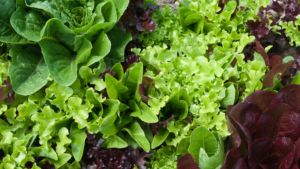
There are some common misconceptions about succession planting that I want to rectify.
- “I need a large garden space”
That’s not true. You can apply succession planting in a raised bed and even in large pots on your patio.
- “Succession planting means planting the same crop repeatedly.”
As you can see above, there are different methods of succession planting, same-crop succession being only one of them.
- “I need to follow a fixed calendar schedule”
Local climate and weather conditions matter far more than a strict schedule. While not leaving out the calendar completely, it’s more important to watch the weather at your place.
- “All plants are suitable for succession planting”
Some main crops like tomatoes and peppers don’t work well with succession planting. Instead, stick to the tried and tested veggies that go well with this concept.
- “It’s too complex for beginners”
Definitely not! Even as a fledgling gardener you can apply basic succession planting methods.
- “Every planting will show the same results”
Unfortunately: no. Growth rates and harvest yield strongly depend on seasonal changes like temperature, moisture and sun hours.
What do we need for succession planting?
Well, first of all, time. Wait, don’t go yet! The time I’m talking of is mostly spent on planning your vegetable garden and especially what to plant and when. Additionally, it costs a bit of time to sow (indoors or outdoors) or plant every few weeks and regularly monitor for harvest timing.
Another thing we need is a continuous supply of seeds or seedlings. You can either seed-start or sow your plants directly or plant seedlings from the nursery into the gaps.
Plants need nutrients, so you have to feed them with compost or other fertilisers.
If you want to extend your season, you’ll need row covers or a cold frame.
Although you have to constantly monitor your garden, the workload is spread throughout the whole season rather than concentrated in spring and fall. This makes gardening more manageable despite requiring consistent attention.
Planning Your Succession Garden

There are a few things you have to observe when planning your succession garden.
First of all, you should make a planting calendar where you indicate when to sow, seed-start and plant what vegetables. Don’t confuse a planting calendar with a planting plan. The first is about timing while the latter is about what veggies you want to plant and where.
The next step is to understand your actual growing season which is determined by frost dates, temperature, daylight hours and microclimate. Your growing season or hardiness zone, indicates the length of time you can grow crops outdoors. Cold frames, winter gardens and greenhouses prolong this growing season. Not sure about your hardiness zone? Find out at this site.
A further important factor to consider is maturity dates, i.e. the time different vegetables need until they can be harvested. This information is usually printed on seed packages or in seed catalogues. If you know, for example, that a certain variety of tomatoes you want to plant needs about 75 days to be harvested, you’ll want to write down when you planted them (for example: May 15th). Then, you can calculate the estimated date of the first harvest, in this case, July 29th. To adjust to local growing conditions, you might want to allow for a wiggle room of 7 – 10 days.
With all that planning, always keep a close eye on how far each of your plants needs to stand from each other. You’ll also find this information on the back of the seed packages or in seed catalogues. I know how tempting it is to reduce the space between plants, especially when they are still young and small. Every gardener has made that mistake at least once. (Some of us more often… ahem). However, vegetables that are planted too close compete for nutrients and space and will stay a good deal smaller than those planted with enough distance from one another.
During the season it’s helpful to keep a record of your gardening. Be it with a software/app or with a traditional handwritten gardening journal, there are a few things that should be covered:
- The crops you choose
- Crop varieties
- Days to maturity
- Expected and actual harvest date
- Notes on the crops’ performance
- Succession intervals
- Space planning
This might look something like this:
| Crop | Variety | Planting date | Days to maturity | Expected harvest | Actual harvest | Yield | Location | Notes |
Feel free to use this chart as an example or create your own and remember to update your chart during the season.
Best Vegetables for Succession Planting
To get a good basis for planning succession planting, we must distinguish between fast-, medium- and slow-growing crops.
Fast-growing crops (30 – 40 days)
- Radishes: Plant every 2 weeks March-September
- Lettuce: Plant every 2-3 weeks March-September
- Arugula: Plant every 2-3 weeks March-September
- Baby Spinach: Plant every 2 weeks March-May, August-September
- Baby Asian Greens: Plant every 2-3 weeks March-September
Make sure you choose the appropriate variety for the respective season (remember: there are cool- and heat-tolerant varieties!)
Medium-Speed Crops (50 – 60 days)
- Bush beans: Sow every three weeks from May to July
- Carrots: Sow every three weeks from April to August
- Beets: Sow every three weeks from April to August
- Kohlrabi: Sow every three weeks from April to August
Slow-Growing Crops (60 + days):
- Tomatoes: staggered plantings 2 – 3 weeks apart in spring
- Peppers: staggered plantings 2 – 3 weeks apart in spring
- Broccoli: Early spring and late summer plantings
- Cabbage: Early spring and late summer plantings
- Brussels Sprouts: Late spring for fall/winter harvest
- Winter Squash: Single planting in late spring
Either grow the Speedy Gonzales veggies between the sloths or let a fast-growing one follow a medium-growing crop.
Season-by-season guide
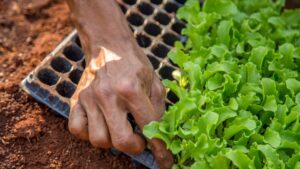
Depending on your hardiness zone, terms like “early spring” and “late summer” can vary considerably. For that reason, let’s define these seasons by their temperature:
– Early Spring (soil temp 5 – 10 °C / 40-50°F)
– Mid-Spring (soil temp 10 – 15 °C / 50-60°F)
– Late Spring/Early Summer (soil temp 15 – 20 °C / 60-70°F)
– Mid-Summer (soil temp 20 – 30 °C / 70-85°F)
– Late Summer/Early Fall (soil temp 15 – 20 °C / 60-70°F)
– Autumn (soil temp 10 – 15 °C / 50-60°F)
That defined, let’s have a look at exemplary tasks that’ll help you to keep your garden’s soil covered and harvest rolling in continually.
Spring succession tips
Prepare the soil as soon as you can work it without smearing it. Remove the mulch to let the soil warm up. Then, rip out all weeds that may have grown, loosen up the soil with a hoe and work in some compost to add nutrients.
Start with cool-season crops like peas, spinach, radishes, and lettuce in early spring (depending on your hardiness zone). Cold frames and low tunnels allow you to plant and sow a few weeks earlier than normal.
Let carrots, beets and Swiss chard follow in Mid-spring. Continue the succession of lettuce and radishes and plant the first bush beans. Now, it’s also time to seed-start indoors the warm-season crops like tomatoes, eggplants, peppers and so on.
In late spring, when the temperature rises, succession plants more quick-growing greens like lettuce, arugula and radishes every 2 weeks.
Continue the greens succession and plant the last cool-season crops before summer.
Summer planting strategies
When late spring changes into early summer, replace the bolting spring crops with heat-tolerant varieties. It’s also time now to plant, summer squash, cucumbers, tomatoes and peppers and other heat-loving vegetables. Continue to plant herbs and leafy greens every 2 – 3 weeks and seed-start fall crops like broccoli, cabbage and kale indoors. Plant out the last set of cucumbers.
In Mid-summer you can sow quick-maturing crops like bush beans directly into the bed.
By the end of August, you can plant a second round of cool-season vegetables like spinach, arugula and lettuce and sow fall root crops like turnips and radishes. Continually plant short-season crops.
Although it can still be hot, consider the first frost date for your region and choose your vegetables accordingly. It’s best now, to cultivate varieties which take no longer than 30 – 45 days to mature. That way you’ll make sure that they ripen before the first frost hits.
Autumn garden planning
Continue to plant cold-hardy greens and root vegetables, always considering the first frost date. If necessary, you can use row covers to protect your vegetables from cold temperatures and thus extend the growing season.
Plant your last batch of quick-maturing crops like spinach and lettuce by mid-September. Now is also the best time to plant garlic for next year’s harvest.
Sow cover crops in every gap that arises when you have harvested or cover the soil with mulch.
Winter preparations
Protect your perennials, like certain herbs as well as vegetables like leek, kale and winter lettuce with covers from the cold.
Winter is the time for planning next year’s garden and succession planting. If you have recorded your garden year in a journal, you can see what worked well and where you can make improvements next year.
In January, you can seed-start the first vegetables for the upcoming season.
Soil Management

As the soil is always covered with crops that take nutrients out of it, it is our task as gardeners to provide exactly those nutrients. After all, we not only want to maintain our soil’s fertility but also to ensure the healthy growth of our plants.
To do that, we start with working compost into the soil in early spring.
When planting strong uptakers like cabbage or tomatoes, we can add well-rotted manure or compost into the plant hole.
During the season, we need to make sure to add organic or mineral fertiliser to give the plants what they need when they need it.
When we have harvested one crop it’s good to loosen the now uncovered soil and work in some compost, well-rotted manure or another long-term fertiliser before sowing or planting the next crop.
Always keep in mind which plants grow great together (and which don’t) and apply the rules of companion planting. That way, we can prevent soil depletion.
Like in nature, our garden’s soil should always be covered, either by plants or by mulch. The cover not only holds the weeds at bay but also retains moisture and prevents the soil from being washed away by rain.
Advanced Succession Strategies
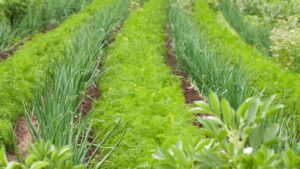
Beyond the basics, there are some advanced strategies you can use that will make you look like a succession planting pro in no time:
Intercropping Techniques
Plant crops together that complement each other, for example, tall corn and low-growing beans. That way you make the most use of your space, keep pests at bay and improve nutrient cycling
Companion Planting
Companion planting means knowing which crops support each other’s growth and strategically placing them together. The combination of tomatoes and basil or carrots and onions are good examples of companion planting. A clever combination of “best buddies” helps to repel pests, enhances nutrients and supports soil health.
Vertical Gardening Methods
Make the most of your space and let your vegetables grow upwards. You can use trellises, for example, where cucumbers, pole beans or winter squash can climb. Or you try hanging pots from carport ceilings or patio canopies and plant them with vegetables. On your balcony or patio, you can also use wall-mounted planters or buy stackable growing systems. Vertical gardening is ideal for small spaces.
Season Extension
With cold frames or a greenhouse, you can extend your region’s growing period. You can sow and plant weeks earlier than outdoors and, depending on your hardiness zone, ensure a year-round harvest, if necessary with a bit of additional protection.
Especially for the first crops outdoors, row covers are a game-changer. They protect the seedlings from harsh weather and temperature variations. Hoop houses create a microclimate that’s beneficial for growing and great for keeping pests out.
Microclimate Creation
With a bit of clever planning, you can create a beneficial microclimate in your garden and thus manipulate your local growing conditions in your favour! My garden, for example, has a slight slope. To prevent the soil from being washed off, I have created the beds at a 90 ° angle to the slope. That way, water is kept longer at the beds’ edges and has more time to seep in.
It’s important to place your plants strategically to create a good microclimate. Large or climbing plants, like corn or pole beans, should be planted at the back of the garden so that they don’t cast a shadow on other plants.
Or you use them as a wind-breaker to protect other, more sensitive plants from harsh winds. A side effect may be the retention of warmth that benefits heat-loving plants like tomatoes and peppers.
Succession in Small Spaces
Gardening in containers is no reason to give up on succession planting. On the contrary: what works in a garden works in containers as well. However, given that we only have a limited amount of soil in containers, fertilising is more important to keep the soil nutritious enough to ensure the healthy growth of your vegetables. Also, use smaller varieties that are better for being grown in containers, like dwarf plant varieties. As with a garden, make a planting and a growing plan.
Succession Planting Wrap-up
You see: a good succession planting strategy can easily provide you with fresh produce during the whole growing season. Just observe the following points:
- To get started with succession planting, begin small by focusing on quick-growing crops like lettuce, radishes, and bush beans.
- Keep a calendar to track planting dates and expected harvest times, taking into consideration your hardiness zone.
- Make sure that you’ve always new crops ready to replace any gaps where plants have been harvested.
- Match the crops to the seasonal temperature ranges. Make sure to plant cold-hardy veggies in spring and late summer and heat-loving ones in late spring / early summer.
- Maintain your soil’s health by working in compost in late winter and spring, fertilising according to your plants’ needs during the growing season and making sure that the soil is continually covered through successive planting.
Start planning your succession schedule now, and you’ll be amazed at how much food you can grow in even a modest garden space.

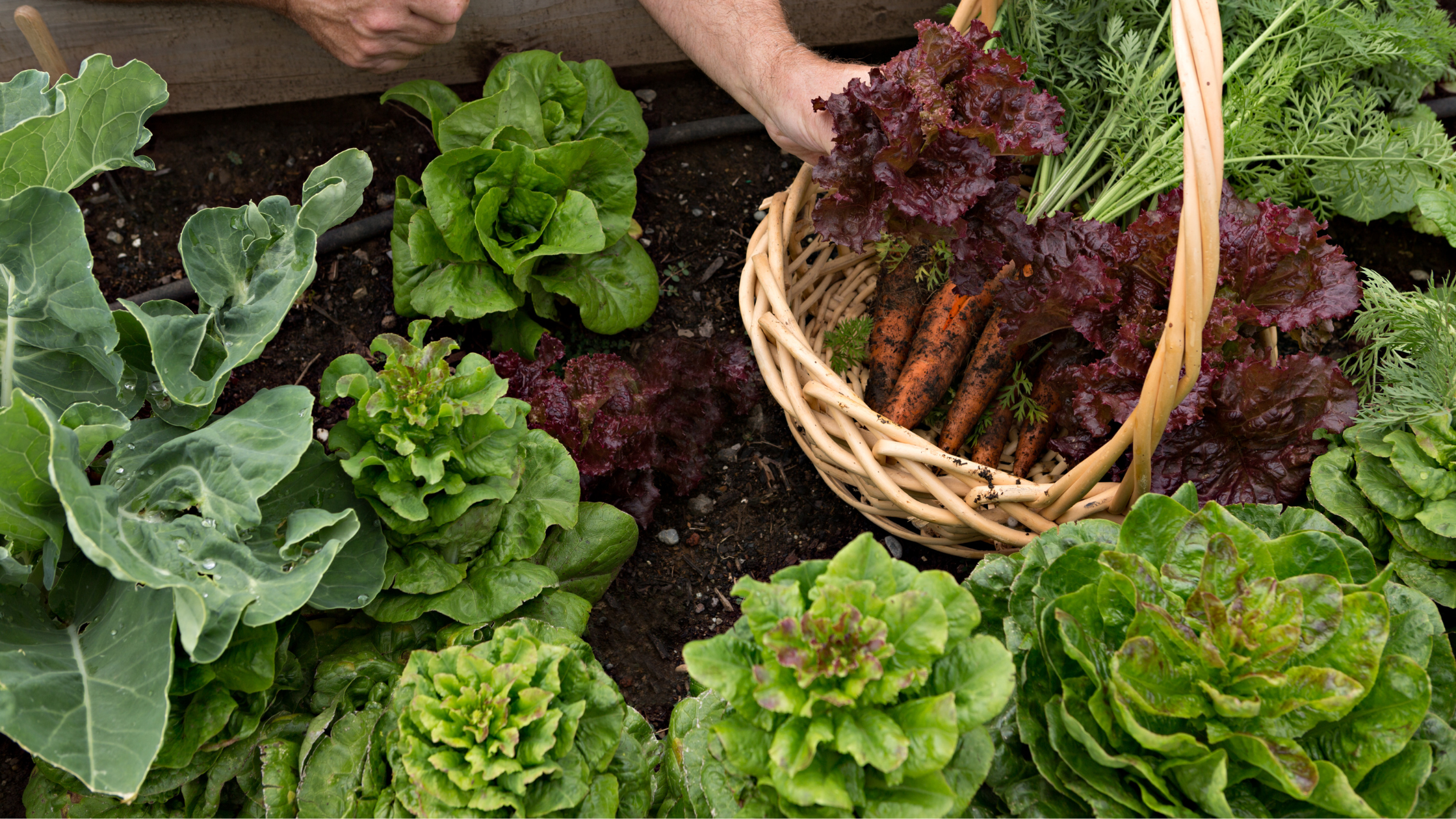
0 Comments